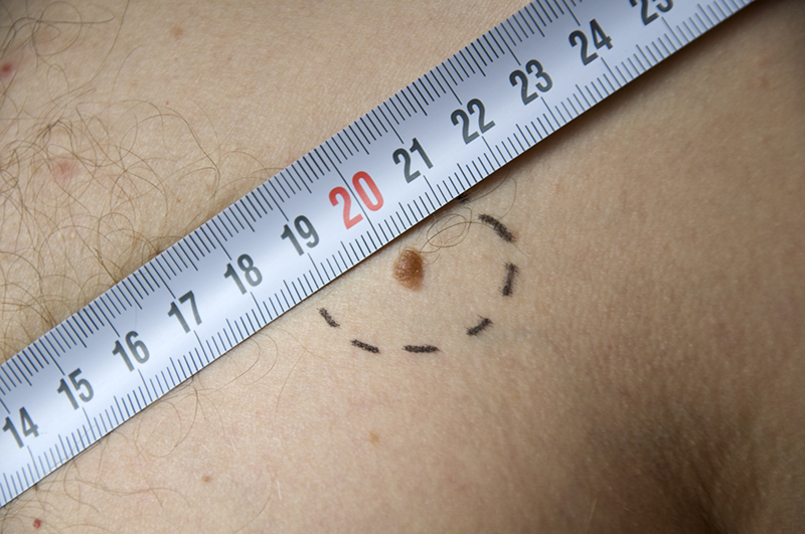Depending on the tissue or organ where the cancer begins, there are around 200 types of cancers and these are called primary cancers. Some cancers have a high likelihood of spreading from one tissue to another and this is called metastasis. Secondary or metastatic cancers are those that have spread from primary locations, the location where they have first appeared. Skin cancers are cancers that start in the skin cells.

The skin:
The outer covering of our body, skin is the largest organ of the body with a surface area of about 20 square feet and it provides both protection and receives stimuli from the environment.
Layers of the skin:
The skin is made of three main layers:
- The epidermis, the outermost layer of the skin which forms a waterproof protective wrapping around the body surface and serves as a barrier for infections. The epidermis does not contain blood vessels and the cells are nourished through diffusion from the dermis.
- The dermis is the layer of skin underneath the epidermis and it contains connective tissue that that cushions the body, nerve endings that provide the sense of touch and heat, blood vessels, hair follicles and sweat glands.
- The hypodermis, also known as subcutaneous tissue is made of fat that serves as padding and insulation for the body and connective tissue to attach the skin to bones and muscles.
Types of skin cells:
There are three main types of skin cells in the epidermis:
- Squamous cells
- Basal cells
- Melanocytes
Functions of the skin:
- Protection: The skin forms an anatomical barrier from pathogens and from the external environment.
- Sensation: The nerve endings in the skin are responsible for the sense of touch, heat, cold, pressure and vibration.
- Heat regulation: The blood vessels in the skin allow control of loss of energy, dilation of blood vessels increases heat loss while their constriction conserves heat. Temperature regulation is also possible through sweating.
- Storage and synthesis: The skin stores lipids and water and is the means of synthesis of vitamin D on exposure to UV.
- Excretion: The excretion of sweat while primarily is for temperature regulation, it excretes urea too though of very low concentration.
- Absorption: The outermost layers of the skin have high absorption and can absorb ointments and other chemicals through patches.
- Water resistance: The skin acts as a water resistant barrier that does not allow nutrients to be washed out of the body.
Risk factors of skin cancer:
- Ultraviolet (UV) radiation emitted by the sun can damage skin cells and genes, which makes it a major risk factor for skin cancer. Tanning lamps and booths are also capable of emitting UV radiation.
- The risk of skin cancer is considerably high for light skinned toned people than for darker skin toned people. The reason being, melanin, the pigment that plays a key role in protection against the UV radiation is responsible for the colour of the skin, people with dark coloured skin have more melanin than fair toned ones.
- The risk of cancers of skin increases with age. People in their old age who may have been exposed to the sun for a longer duration of time are seen to be at risk.
- Men are twice at risk than women to some types of skin cancers and about thrice for others. This could be accounted to the amount of time in the sun spent for the genders though.
- The risk of skin cancer increases with exposures to larger amounts of arsenic which is used in making of some insecticides.
- People who may have undergone radiation treatment have a risk of acquiring a skin cancer in the treated area.
- People who have had one keratinocyte cancer in the past have much of a chance at having another one.
- Xeroderma pigmentosum is a rare inherited disease which makes the skin very unable to repair damage caused by the sun or decrease the capacity to repair the damage. People with this disease have a higher risk of acquiring many skin cancers, some starting in childhood itself.
- Cancer seems to develop in people with weak immune systems. Skin cancers in people with weak immune systems tend to grow quickly and are more likely to cause death.
- Human papillomavirus (HPV) can be linked with a considerable amount of skin cancers.
- Smoking can be a risk factor for few types of skin cancers but not for all.
- In these people, certain parts of the normal cells are more sensitive to being damaged by sunlight.
- A mole can be viewed as a non cancerous skin tumor. However, moles of certain kind may increase the chance of a person being affected with melanoma.
Types of skin cancers:
The epidermis is made up of three types of cells- basal cells, squamous cells and melanocytes. Cancer that develops in these tissues are the most common skin cancers. Following are these common types of skin cancer:
Basal cell carcinoma:
Basal cell carcinoma is rarely staged as these are almost always cured before they spread to other parts of the body, however in the cases where it needs to be staged, TNM method of staging is used. The staging is different for other parts of the body and for eyelids as the size of the tumour differs in scale.
Squamous cell carcinoma:
Squamous cell carcinoma usually occurs in the head and the neck regions and is more likely to recur and also spread to other parts of the body when compared to basal cell carcinoma and hence the staging is important for this type.
Melanoma Skin Cancer:
Melanoma is the cancer that starts in the melanocytes. These are skin cells that make a deep brown pigment called melanin which is responsible to give the skin its colour. It protects the deep layers of the skin from the effects of the sun and exposure to sun increases the production of melanin making people get tan or get darker.
Rare types of skin cancer:
Out of all the patients who have been diagnosed with skin cancer, only 2% of them have the following cancers:
- Merkel cell carcinoma
- Cutaneous T-cell lymphoma (CTCL)
- Kaposi’s Sarcoma (KS)
- Sebaceous Gland Carcinoma (SGC)
- Dermatofibrosarcoma Protuberans (DFSP)
Read more about types of skin cancer here.
Symptoms of skin cancer:
The symptoms of the skin cancer can depend on the type of skin cancer too. The following are the symptoms of the common types of skin cancer:
Basal cell carcinoma:
- Sores or moles that appear smooth and pearly, look waxy or appear as a firm, red lump
- These may bleed sometimes, developing a crust or scab
- They begin to heal but never completely heal
- These can be itchy too
- It may develop into a painless ulcer.
Squamous cell carcinoma:
- Red and scaly patches of the skin that bleed
- Bleeding sores
- Skin growths which are raised with a center indent that are often tender and bleed
- A wart-like growth that crusts and bleed
- Itching, inflammation and tenderness in the affected areas
Melanoma:
- Changes in size, colour or feel of common (normal) moles
- Bleeding moles
- Brownish spot with dark speckles.
- Dark lessons on the affected areas
- Small lesions that appear red, white, blue or blue-black with an irregular border and portions
Know more about symptoms of skin cancer here.
Diagnosis of skin cancer:
The symptom of skin cancer is very often a skin lesion, except for advanced stages. Most patients who examine their own skin regularly may spot suspicious skin changes and report them. This is what happens in at least 40% of the cases. If the doctor suspects skin cancer, a biopsy is performed to confirm the presence of cancer.
Biopsy:
A common test to diagnose a skin cancer is a skin biopsy. A skin tissue is extracted and sent to a laboratory for pathological study. A biopsy not only identifies a cancers skin tissue but also helps in diagnosing the stage of cancer. A local anesthesia is administered while performing skin biopsies. There are many types of biopsies available, the exact type to be performed over a particular patient depends upon the the size of skin, location among other factors. Following are the types of biopsies used for confirming skin cancers:
- Shave (tangential) biopsy
- Punch biopsy
- Incisional or excisional biopsies
- Optical biopsies
Biopsies for melanoma that might have spread:
Skin cancer can also spread to other organs of the body like lungs and lymph nodes. This can happen after the appearance of a skin lesion or while it is developing or even after its disappearance. These kind of tumors are found using imaging test such as CT scan and the spread is established by different kind of biopsies that are performed such as:
- Fine needle aspiration (FNA) biopsy
- Surgical (excisional) lymph node biopsy
- Sentinel lymph node biopsy
Imaging Tests:
Imaging tests are often used to see the possible metastasized melanoma cells in the body using x-rays, radioactive substances, magnetic fields to create pictures of the body from inside. This is done in advanced stages of cancer only. It helps to determine the effectiveness of treatment and find recurring cancers. These tests include:
- Chest X ray
- CT scan
- PET scan
- MRI
- CT-PET scan
Blood tests:
Blood test may not directly diagnose the presence of a cancer, however the extent of spread can be diagnosed by looking at the blood picture of a patient. The working condition of bone marrow, liver, and kidneys is determined using the blood chemistry levels in patients with advanced stages of melanoma.
Read more about diagnosis of skin cancer here.
Stages of skin cancer:
Staging:
Staging standardizes the process of describing how much the cancer has spread in the body. Staging of cancer helps the doctors figure out how much the cancer has spread and determine its best treatment and also helps calculate survival statistics. The lower the number of the stage, the less is the cancer has spread, with early stages being 1 and the most advanced stage being 4.
Most cancers that have tumours are staged using a staging system called TNM system and the same is used for skin cancers. The size of the primary tumour (T), the presence of cancerous lymph nodes (N) and how far the skin cancer has spread to a different part of the body (M) can be described using the TNM system. High risk features is another important parameter used to determine the staging of skin cancers.
High risk features:
The following are the high risk features of skin cancer:
- The cancer is more than 2 mm thick in diameter
- It has grown into the lower dermis
- It has grown into the space around a nerve
- It started to spread to the ear or lip
- The cells are poorly differentiated or undifferentiated when seen in a microscope
Stages of non melanomas:
- Stage I: The cancer is 2 cm across or lesser and has one or no high risk features.
- Stage II: The cancer is 2 cm across and has two or more high risk features.
- Stage III: The cancer has grown into into the bones in the face, like the jaw bone or the bone around the eye or it has spread to a nearby lymph node than it less than 3 cm in size.
- Stage IV: The cancer has spread into the spine, lower part of the skull or the ribs or it has spread to a lymph node more than 3 cm in size or to an internal organ such as the lungs.
Treatment methods:
The following are the major treatment options available for treating skin cancers:
Skin Cancer Surgery:
Surgery is the most common and preferred treatment option for skin cancers. The tumour or cancer containing area of the skin is removed along with some amount of surrounding tissue. The exact procedure depends on the type of surgery done. The following are the different types of surgeries available to treat skin cancers, the exact type is chosen based on the requirement of the patient and the location of the cancer.
- Mohs surgery
- Excision
- Curettage and electrodessication
- Cryosurgery
- Laser surgery
Read more about surgery for skin cancer here.
Targeted therapy:
This treatment uses drugs that target the cancerous cells. They avoid causing extreme damage to the remaining healthy cells which can occur in chemotherapy. As a part of targeted therapy in treating recurrent basal cell carcinoma, a signal transduction inhibitor is used. These inhibitors block the signals that pass between molecules in the cells, which leads to death of those cells.
Immunotherapy:
Immunotherapy aims in making the patient’s immune system stronger by using artificial substances to restore the body’s defense against cancer. This procedure is also known as biotherapy or biologic therapy. The most common drugs used as a part of immunotherapy are interferon and imiquimod, out of which interferon is given as an injection and imiquimod is applied as an ointment to the skin.
Photodynamic therapy (PDT):
This treatment uses a particular type of laser light to cure skin cancer. It is often given along with other drugs, which are inactive when until exposure to the laser light. These drugs are given intravenously or places on the skin, and are accumulated more in cancer cells than the normal ones. The major disadvantage of this treatment is the damage it causes to the healthy tissues.
Read more about other treatment options for skin cancer here.
Chemotherapy for Skin Cancer:
Chemotherapy uses drugs to kill cancer cells throughout the body and is used if the skin cancer has metastasized and spread to other organs. It is not the standard treatment for this cancer type though unless the cancer has advanced. The treatment is given in cycles of medication and rest to allow the body to recover and reduce the intensity of side effects. Read more about drugs prescribed for skin cancer here.
Radiation therapy for Skin Cancer:
In radiation therapy, high energy X rays to destroy the cancerous cells. Radiation is given to the patients under strict monitored doses to control the growth of the cancerous cells. It is often given before/after surgeries or in combination with chemotherapy. The main benefit of this treatment is that is does not just kill the cancer cells but also helps in reducing pain and other symptoms of the cancer. Read more about radiotherapy for skin cancer here.
Prevention of skin cancer:
In order to prevent skin cancer, it is highly recommended that people should reduce their exposure to ultraviolet rays. Following are the preventive measures one must follow to avoid the development of skin cancer:
- Avoid direct contact with the sun between 10 a.m. to 4 p.m.
- Wearing hats or caps, UV-blocking sunglasses, long sleeves clothes and full pants are advised
- During extreme hot days, especially in the summer, seek shade when outdoors
- When staying out in the sun for more than 20 minutes, a water-resistant sunscreen with a SPF (sun protection factor) of 30 or higher is recommended
- Sunglasses with UVA and UVB protection are recommended
- Avoid sunburns, as people with sunburns are at a higher risk of developing skin cancer
- Tanning booths and beds which use UV light are strictly not recommended
- Infants and kids are not recommended to be exposed to direct sunlight
- Consult a doctor for any suspicious spots
- Periodic skin checks with a dermatologist, at least once a year are advised



